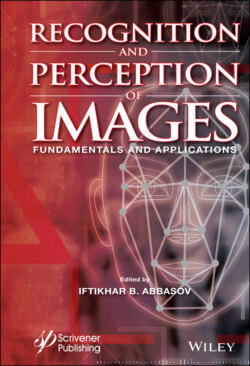Читать книгу Recognition and Perception of Images - Группа авторов - Страница 27
Subjective Color Sensations
ОглавлениеExperimental confirmation [Shiffman, 2008]. For 30 seconds, carefully examine the center of the rectangle with a diagonal pattern (Figure 1.2.23). You will begin to notice weak, unstable colored “streams” moving perpendicular to the black diagonal lines. Due to the micromovements of the eyeball, the image of the diagonals on the retina constantly moves, causing the rhythmic activity of the higher-level neurons of the visual system. Such patterns are not found in nature, so the visual system comes to an unstable state. This effect is most likely due to the fact that the size of the retinal projection of the structural parts of the image becomes co-measured with the size of the cone receptors themselves. In this case, the visual system goes into an unstable resonance mode, which causes illusions in the processing and perception of this visual information by the brain. Depending on the distance, the consequent retinal image size, this effect decreases or intensifies [Abbasov, 2016].
The work of [Doliotis et al., 2009] considers the phenomenology of colorblindness because up to 8-12% of men and 0.5% of women of European countries suffer from this abnormality of color sensation. Due to this, the necessity to work out the methods of modification of colored digital images to improve their perception by people with the defective vision has arisen. The particular data on the working out of methods of images modification for the color-blind people of the first category (protanopes that are insensitive to shades of red) are presented in the article. The colors causing the impairment of protanopes are assigned in the separate group, and the images are corrected and adapted for their perception [Itten, 2001]. The time of images processing is reduced due to the use of color quantization. This method but slightly changed may be also used for other types of color impairment. It may be applied to the deuteranopes who have some difficulty distinguishing shades of green.
Figure 1.2.23 Achromatic pattern that causes subjective color sensations.
Figure 1.2.24 Illustration based on dark shades of red and green and color illustration in the same shades of gray, color illustration, which in the gray version turns into a singlecolor image (horizontal strip) [Abbasov, 2013].
Figure 1.2.24, at the top shows an example of an illustration based on the dark shades of red and green. These shades are difficult to see (also for the author of the chapter), especially in a small area of the image. I would like to note that also these shades have the same tonality in the gray version. In the center for distraction, contrasting shades of blue, yellow and white are shown.
Figure 1.2.24, below, is a color illustration, which in the gray version turns into a single-color image (horizontal strip). This emphasizes the important role of color vision in human life. By the way, the color of the adjacent areas of the image is induced on this gray strip, although it is just gray [Abbasov, 2013].
